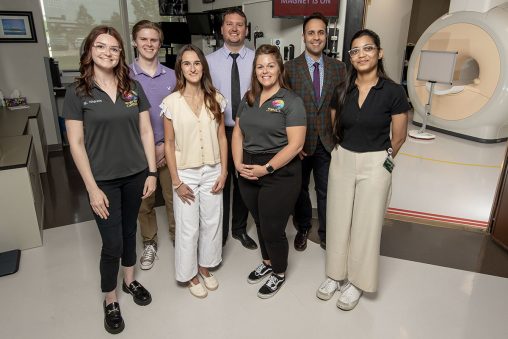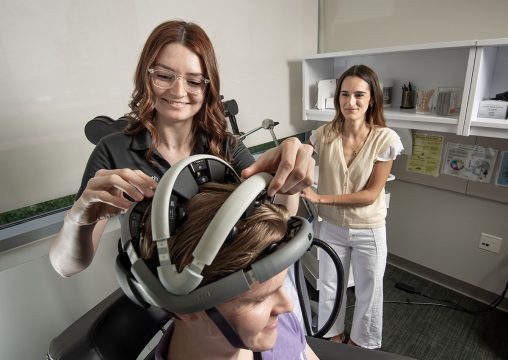
Wright State faculty and student researchers in the departments of Neuroscience, Cell Biology and Physiology and Biomedical, Industrial and Human Factors Engineering are leading a cutting-edge clinical study to treat symptoms of post-traumatic stress disorder in military veterans and first responders. (Photos by Erin Pence)
Wright State University is advancing mental health treatment through a cutting-edge clinical study exploring the use of electroencephalogram transcranial magnetic stimulation (eTMS) to treat symptoms of post-traumatic stress disorder (PTSD) in military veterans and first responders.
Following a successful Phase 1 trial, Wright State researchers have launched the second phase of the study to evaluate the efficacy of eTMS therapy, an investigational, non-invasive brain stimulation technique that shows promise as a powerful new tool in trauma recovery.
Matt Sherwood, Ph.D., a research associate professor in the Department of Neuroscience, Cell Biology and Physiology at Wright State, leads the study.
He has teamed with JLC Services, Inc., and partner sponsor Wave Neuroscience, along with Hugh Salehi, Ph.D., assistant professor in the Department of Biomedical, Industrial and Human Factors Engineering, three doctoral students, two master’s students and two undergraduate students.
The clinical trial not only demonstrates Wright State’s commitment to research but also offers students hands-on experience in real-world clinical science.
“The first phase of the study was extremely successful,” Sherwood said. “The purpose was to demonstrate the safety of the investigational treatment to proceed to Phase 2. We had no occurrences of serious adverse events.”
The most important finding was in treatment efficacy. Participants in Phase 1 experienced a rate of improvement nearly three times greater than the standard benchmark, as measured by a PTSD assessment tool.
Funded by the Ohio Department of Mental Health and Addiction Services (OhioMHAS), the study has dual goals: to offer off-label treatment access at no cost to veterans and first responders and to seek FDA approval for the eTMS protocol.
Wright State is contributing to the latter by conducting a randomized clinical trial at one of the two study locations — on the Dayton Campus and in Pickerington, Ohio. The study aims to enroll 110 participants by November, with each completing 30 treatment sessions over 15 visits.
“For this phase, we are looking to evaluate treatment efficacy using a randomized clinical trial,” said Sherwood. “Unfortunately, we do have to provide sham treatment to half of our participants in a randomized fashion. This is really the best way available to identify actual treatment effects and effectiveness.”
Beyond the research, the study serves as an innovative educational opportunity for students, who will be responsible for administering treatments and managing data collection, giving them critical experience in areas like data integrity, research ethics and organizational skills.

Clockwise from top right: Wright State students Celia Barba-Soriano, Douglas Sattler and Megan Hildreth demonstrate the electroencephalogram transcranial magnetic stimulation device used in a PTSD clinical study by Wright State researchers.
Cody Clark, who is pursuing a Ph.D. in biomedical engineering, studied with Sherwood as an instructor when an undergraduate student and jumped at the chance to work with him on this project. Clark, who plans to enroll at Wright State’s Boonshoft School of Medicine to train as a surgeon, said the experience has given him valuable clinical experience.
“I’ve had the opportunity to learn advanced data analysis techniques,” he said, “and I’ve learned more about how MRIs work, even getting to run through the procedures during scans and methods of evaluation.”
Another key contributor, Meghana Kasana, Pharm.D., is pursuing a master’s degree in pharmacology and toxicology at the Boonshoft School of Medicine. She is honing her expertise in neuroimaging and neuromodulation, while preparing for a career in regulatory clinical research.
“I’m very excited about this opportunity because of my prior experience with clinical trials and what the study hopes to achieve,” Kasana said. “I think I’ll learn a lot about running clinical trials, checking out neuroimaging data and making sure we follow all the regulatory guidelines.”

 Wright State Police Department delivers major donation to Raider Food Pantry
Wright State Police Department delivers major donation to Raider Food Pantry  Wright State engineering and computer science students earn prestigious federal SMART Scholarships
Wright State engineering and computer science students earn prestigious federal SMART Scholarships  Wright State Police Chief Kurt Holden selected for prestigious FBI National Academy program
Wright State Police Chief Kurt Holden selected for prestigious FBI National Academy program  Wright State’s Raj Soin College of Business ranked among the best for entrepreneurs by Princeton Review
Wright State’s Raj Soin College of Business ranked among the best for entrepreneurs by Princeton Review  Wright State’s annual Raidersgiving draws hundreds
Wright State’s annual Raidersgiving draws hundreds 